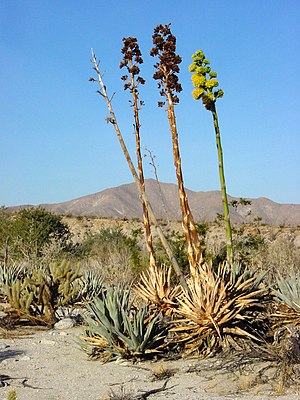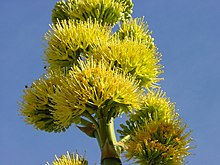Agave deserti
| Agave deserti | ||||||||||||
|---|---|---|---|---|---|---|---|---|---|---|---|---|

Agave deserti |
||||||||||||
| Systematics | ||||||||||||
|
||||||||||||
| Scientific name | ||||||||||||
| Agave deserti | ||||||||||||
| Engelm. |
Agave deserti is a plant from the genus of the Agave ( agave ). An English common name is "Desert Agave".
description
Agave deserti grows in rosettes and forms sparse or numerous runners . The leaf rosette reaches heights of 30 to 50 centimeters and a diameter of 40 to 60 centimeters. The variable, thick, rigid leaves are lanceolate to linear-lanceolate and barely narrowed over the broad base that encompasses the stalk. They are moderately pointed, convex on the bottom and concave on the top. The gray to bluish glauken , often cross-banded leaves are usually 25 to 40 centimeters long and 6 to 8 centimeters wide. The leaf margins are usually straight and usually regularly covered with loosely attached, gray marginal teeth, which are usually 1.5 to 3 centimeters apart and 2 to 3 millimeters long. The leaves end in a strong, light brown to grayish terminal spine, usually 2 to 4 centimeters in length.
The 2.5 to 4 meter high inflorescence is paniculate. The 6 to 15 small partial inflorescences are in the upper fifth to upper quarter of the inflorescence. The individual flowers are 4 to 6 inches long. Their yellow tepals have the same tip 14 to 20 millimeters in length. The flower tube is 4 to 6 millimeters long.
The chromosome number is .
Systematics and distribution
Agave deserti is widespread in the southwestern United States in the states of California (south only) and Arizona, and in Mexico in the states of Sonora and Baja California .
The first description was published in 1875 by George Engelmann . The following subspecies are distinguished:
- Agave deserti subsp. deserti
- Agave deserti subsp. pringlei (Engelm. ex Baker) Gentry
- Agave deserti subsp. simplex gentry
Agave deserti a representative of the Deserticolae group . The variability within the populations in the extensive range is very high. Wendy C. Hodgson and James Lauritz Reveal therefore classified the subspecies as varieties in 2001.
proof
literature
- J. Thiede: Agave deserti. In: Urs Eggli (Hrsg.): Succulent lexicon. Monocotyledons . Eugen Ulmer, Stuttgart 2001, ISBN 3-8001-3662-7 , pp. 25-26.
Individual evidence
- ↑ Agave deserti in the Calflora Database .
- ^ Transactions of the Academy of Science of Saint Louis . Volume 3, St. Louis 1875, p. 310.
- ↑ Howard Scott Gentry: Agaves of Continental North America . 1982, p. 376.
- ↑ Wendy C. Hodgson: Taxonomic Novelties in American Agave (Agavaceae). In: Novon. Volume 11, Number 4, 2001, pp. 410-416 (JSTOR) .
further reading
- August J. Spread: Agave deserti. In: The Agaves. The Cactus & Succulent Journal Yearbook. 1968, pp. 85-86.
- Howard Scott Gentry: Agaves of Continental North America . University of Arizona Press, 1982, ISBN 0-8165-0775-9 , pp. 376-379.
- Thomas Heller: Agaves . Ntv, Münster 2006, ISBN 3-937285-59-8 , pp. 80-81.
- Mary & Gary Irish: Agaves, yuccas, and related plants. A Gardener's Guide. Timber Press, 2000, ISBN 0-88192-442-3 , pp. 115-116, pl. 14.
- James L. Reveal, Wendy C. Hodgson: Flora of North America Agavaceae . Oxford University Press, 2002, pp. 458-459 .


